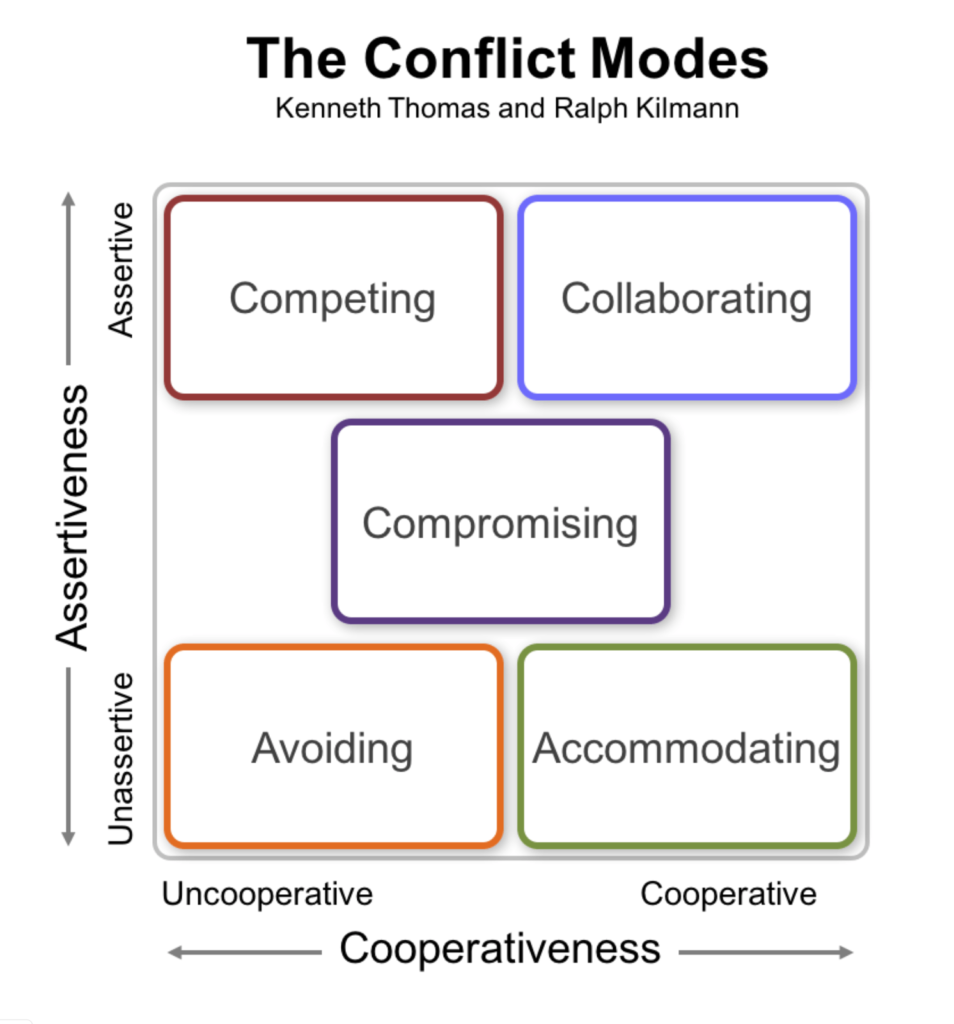Tolstoy’s War and Peace is over 1,000 pages and takes a very long time to read. But as a project manager, war and peace are things you could face every single day at work.
Okay, that’s an exaggeration. It’s definitely not war, but conflict does come in the way of many projects. Those who are successful at project management know that sometimes, this is inevitable. They have ways to defuse situations, which then lead to winning outcomes.
Conflict management is a crucial weapon in any project manager’s arsenal. Let’s explore how and why it arises, and the steps you can take to turn it into a win-win situation.
Why Conflict Is Bad, and Why a Little Bit Can Be Good
Here’s one way of looking at it. When there is a group of people working together, each member could have different attitudes and ways of working towards a goal. When these differences become incompatible, conflict arises. This leads to disagreements, working at cross-purposes, delays, revisions, and meetings that never seem to end. (Sound familiar?)
Clearly, no project is going to be successful if this is allowed to continue. As a project manager, it is your responsibility to see all sides and devise a strategy such that the conflict is resolved, so everyone works together as one unit. This is how the best project managers resolve differences, deliver on time, are looked up to, and respected.
There are times, though, when conflict can be productive. Different points of view are expressed openly, various angles are debated, lessons are learned, and people gain a renewed sense of purpose.
After all, every workplace needs some amount of spirit to thrive. Dullness and conformity are in no-one’s best interests.
However, healthy or not, all conflict must be carefully managed, so it doesn’t get out of hand. Sometimes, what one thinks is a small amount of productive conflict can spiral into something bigger. This has been known to stall and delay plans unnecessarily. Clearly, you don’t want that happening when it comes to your projects. With this in mind, let us examine the roots of conflict to begin to understand conflict and manipulate it to your advantage.
The Five Roots of Conflict
Sometimes, the organization’s culture and the nature of work may give rise to conflicts. To categorize further, there are five overall reasons.
- A competitive attitude
Many times, people, working together, become afflicted by one-upmanship. They want to prove that they are the best in terms of getting the job done. This obviously will offend others who feel disregarded. Competition and not cooperation takes over and an unsafe, stressful environment is created. Managers should encourage healthy competition and nip animosity and feelings of rivalry in the bud. - Lack of clarity
With some projects, there is a lack of clarity on objectives from the start. At other times, the objectives can change during the course of a project. This vagueness means that people interpret their tasks in different ways, and conflicting issues can arise. Over time, this leads to more talking and less doing. Adopt a system such as a project or task management tool that will prove as the unique source of truth to eliminate misunderstandings and provide your team clear direction. Task management software also promotes transparency and accountability which further minimize reasons for conflict.

- Lack of information
For any project to be a success, it’s important that all the team members and stakeholders are aware of all the issues involved during all times. Of course, people will specialize in different tasks, but overall information to execute a project must be made available. When this does not happen, people may act in ways they think are helpful, but actually can hold up the project. Communication and a clear demarcation of roles, responsibilities and operational goals is necessary for a team to function without friction.
- Too much of centralization in authority
A culture that is open and safe encourages people to speak up in a productive manner. Too much of centralization leads to the opposite. The needs and voices of team members can be ignored, and the completion of tasks is jeopardized. This can lead to feelings of resentment, which, of course, causes conflict. Project managers should encourage a culture of openness and creative problem solving and ask teammates to voice their ideas, suggestions and opinions without hesitation.
- Too little certainty
This is linked to the points of information and clarity mentioned above. When team members are uncertain about their roles, and when the project itself is ill-defined, they can act in disagreeable ways, leading to conflict. The intentions may be right, but the way in which the problem is addressed leads to unnecessary disputes. Project managers must ensure that all information percolates to all levels of hierarchy in the team.
Conflict can emerge all of a sudden, or it can simmer below the surface for a long time. The indications of hidden conflict often are suppressed hostility, a lack of co-operation, limited, time-bound work, or even a rumor-mongering atmosphere.
This is obviously unhealthy and needs to be resolved with promptness. Let us start with approaches you can adopt to understand and deal with conflicts.
Some Approaches to Managing Conflicts
There are many methods of resolving conflicts. Which ones are to be applied depends on the dynamics of any given situation. To begin with, let’s discuss two common methods which are not generally recommended, especially for the long-term.
Forcing the Issue
There are times when a project manager simply lays down the law and insists that everyone behaves in a manner that is expected. This may take care of a specific conflict that is holding up a project, but you can be sure that it’s only for the short-term. The conflict will arise again, maybe in a more severe form, as underlying issues have not been settled.
Avoiding the Problem
This one is the exact opposite. Sometimes, conflict is simply ignored. Here, there is hope that it will go away on its own, and that work will be unaffected. Again, this may provide relief in the short-term. But the nature of conflicts that are not addressed is that they will rise and fall and rise again.
Beware – the problem could become chronic.
Now, let’s look at a few that do work, and should decrease levels of conflict.
-
- Identifying roles and objectives – Often times, there is conflict because people are unsure about what they are supposed to be doing and when. This confusion can also extend to what other team members are supposed to be doing. The best way to avoid this is to be very clear about what is expected from each person. Lines of control can be established, project descriptions laid out, and everyone can be brought into alignment when it comes to objectives.
- Starting dialogues – Often, conflict can arise because people feel that they aren’t being heard. Feelings of resentment can cause disagreements and encounters that lead nowhere. In such cases, it’s important to create a culture where open, healthy conversations can flourish. Talk to team members often, and encourage them to talk to each other. An important point here is the element of compromise. To address differences through dialogue, there has to be give-and-take, so all sides feel they have achieved something.
- Develop teams – This is, of course, not separate from the above, but important enough to be discussed separately. With a spirit of friendliness, mutual respect, and co-operation, teams can be developed to work together without unnecessary conflict. This can involve laying down ground rules, role definitions, group norms, and adhering to best project management practices. Do also remember to celebrate successes big and small together, be this in the office or out of it. One thing that helps teams bond better, co-operate with each other, and build mutual understanding is to strip the barrier of formality that remains. This can be done with team building games and problem solving activities that everyone will enjoy.

Expert Opinion on Conflict Resolution
Harold Kerzner, a consultant and conflict resolution expert, has outlined five conflict resolution habits in his book ‘Project Management.’ These are:
- Confronting
This means addressing everyone’s issues directly and coming up with a win-win resolution. In an ideal scenario, all parties achieve goals and are satisfied.
- Compromising
Here, both parties give up some goals to achieve others. This calls for a degree of mutual respect and understanding.
- Smoothing
This is a partial resolution. Common agreements are emphasized, and disagreements are minimized. The hope is that lessons are learned.
- Forcing
Again, this an incomplete and short-term resolution. One party is satisfied, and the other is ignored. The conflict has not been successfully managed
- Avoiding
This is not a resolution at all. The overall issues remain unresolved and can very well surface again soon.
What Conflict Management Mode is the Best?
Psychologists have come up with something that is called the Thomas-Kilmann model. This illustrates the options of handling conflict and links it to temperament.

We’ve already discussed versions of these above. Competing, accommodating, avoiding, compromising, and collaborating.
Taking this a step further, one has to ask: which mode works best and at which times?
The answer to that depends on personality types as well as the specific situation. Thomas and Kilman list five such categories.
- The Accommodator
Here, a person places the highest value on satisfying the needs of others. Not assertion, but rather, cooperation is the method. This is useful if the success of the project is more important than the egos of individuals.
- The Competitor
In this case, a person puts his own interests first. Assertion levels are high. This can be useful in cases of emergencies when quick decisions are vital. But this can also cause long-term resentment.
- The Avoider
These people simply evade the issues. There is too much delegation and exaggerated respect for others. For small conflicts, this is fine. Otherwise, it will not work.
- The Compromiser
A compromiser tries to manage both sides by giving in to both sides. He tends to give up a lot in order to respect the deadline and wants to make sure the project is completed and not stalled.
- The Collaborator
Finally, this person tries to reach a solution that makes all parties happy. They use a level of assertion as well as consideration. The outcome is a win-win situation and great for handling long-term conflict.
Why Handle Conflict Anyway?
Now, you could well ask – why go to all this trouble to handle conflict? Isn’t it more important to just get the job done in any manner?
The fact is, the efficient resolution of conflicts at work has several benefits. And not addressing it can be extremely damaging.
A CPP Global study found that conflict that is unaddressed will undermine cooperation and teamwork, and will reduce productivity. In extreme cases, there could be high employee turnover, missed deadlines, high stress, and a hostile environment.
Conflict, in short, drains energy, time, and money. As a project manager, that’s the last thing you want.
A conflict-free workplace, however, has several strategic advantages. Employee cooperation is improved, teamwork and spirits are high, and engagement and productivity are boosted.
Such improved relationships give rise to creative solutions and lasting relationships among all concerned, leading to successful project completions that you can celebrate.

To Solve Conflicts, Understand Them
By now, you’re aware of the primary reasons that conflicts can arise, and the tools to solve them.
It’s often been noticed, however, that no sooner has a conflict been resolved than another one arises. That’s because there is a final step that needs to be taken in order for truly effective conflict management and resolution.
As with anything else, understanding the underlying causes of workplace conflict is extremely important. Time and patience are needed to recognize these and to solve them.
Let us look at some examples. If there are repeated clashes over deadlines, it could be that you need to set up efficient project management software so that all concerned teammates and stakeholders are in the loop at every step of the way. If the conflict is between teams and external stakeholders over the scope of a project, a requirements management tool will ensure real-time collaboration and measures that will check scope creep or disagreements.
Again, sometimes a project has to be redone over and over again, and this causes finger-pointing. Here, it could well be that at the start of every single project, you need to lay down roles, responsibilities, and objectives clearly.
In short, not all conflicts may be what they look like on the surface. With a little digging, you can root out the causes and make sure they do not arise again.
Once you’ve done this, you can further make sure that you use the right techniques to handle further disagreements, if any. Then, you can lean back with the satisfaction of not only delivering a project successfully but also laying a long-term foundation for a happy and successful career.






0 Comments